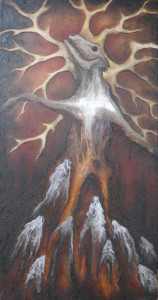Oil on Canvas 18″ x 36″
The essential composite and dynamics of the universe are undeniable; entropy consumes with the same inevitability as the generative element creates and recreates. That the cycle of these phenomenon exist as axiomatic truths however has not inhibited their obfuscation. Indeed, how various schemas have chosen to interpret the presences of death specifically has varied greatly. One of the distinguishing features that has emerged in contemporary Christianity for instance is its near universal externalization of the destructive.
For those familiar only with the estrangement of destruction, its malignancy can seem self-evident. Contrasting counterexamples however abound. Ranging from the embraced violence of mesoamerican mythology, to its acceptance of it in the near-eastern pantheon, destruction is rarely found only in the other. Far from being considered opposed to the divine, in dharmic theology, destruction is often seen as a central, and sometimes even ultimate, aspect of the divine. In such cases undoing, no less than doing, is rightly perceived as a necessary aspect of the whole.
In Christianity, that the creative is considered not just a dominate trait of a complex entity, but indeed as the primary, if not sole, aspect of the Godhead, is telling. While earlier incarnations of the Abrahamic El do place an emphasis on the creative aspects of the deity, so too do they also acknowledge the ruinous. Not surprisingly, as the concept of the destructive divine became increasingly unpalatable, the personification of destruction emerged as an inherently independent, invasive, figure. That this figure ultimately took on the form of earlier horned and hoofed nature deities is far from coincidental.
In the natural, world death is a constant presence which grants life to many even as it robs it from some: from the ashes of the forest fire grows new life; the lion that kills the lamb feeds its young with the refuse. Destruction of the old is always necessary and central to the growth of the new. This incontrovertible character is in direct contrast to the divine peace emphasized as the modern Christian ideal. In this context it is not surprising that the personification of the wild would take on a threatening aspect. Indeed, in the horned being of life and death is found all that is missing in sterilized ideals of static perfection.
Perhaps the ultimate example of this perceptual shift is contained in the Christ story itself. In a mythology centered on rebirth there can, with equal emphasis, be perceived the importance of death as of life. Rather than a conquest over death, the role of destruction in the resurrection should be seen as the divine catalyst for new life. When instead an excision is attempted on a necessary process, an impassable divide is created between existence and its imagined ideal. This sundering not only results in the separation of the divine from the natural, but also the division of man from the divine. It is impossible to love something without accepting the totality of it.


